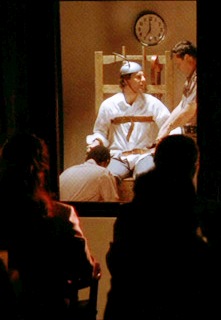“Last Dance Before an Execution”: May 12, 1971
Original airdate: May 1, 1991
Visit the Quantum Leap Rewatch index
Sam leaped into some pretty chilling situations over the five-season run of Quantum Leap, but one of the most intense and frightening has got to be his arrival in “Last Dance before an Execution.” In it, he finds himself strapped into the electric chair in lieu of Jesus Ortega, a convicted murderer who was about to face death at the hands of the State of Florida.
Fortunately for Sam, a last-minute call from the Governor comes through, getting him out of that pickle… but his sentence has not been commuted. Jesus has instead gotten a stay of execution, and it’s only for a couple of days.
With the clock ticking, the mission seems pretty clear: Sam wouldn’t be on death row unless some miscarriage of justice was about to occur, right? So what remains is to puzzle out whether Jesus is innocent, and if so how to prove it. By digging through documents in his cell Sam learns that Jesus is one of two men convicted of murdering a priest. He and an accomplice—Raul Casta, who is in the cell next door—even confessed to stealing six dollars from a church poorbox. For years, though, they have steadfastly claimed that neither of them committed the murder.
Sam’s quest to prove the men innocent is complicated by the fact that he’s got to do it from the confines of a tiny prison cell. He has two allies. There’s Al, of course, and there’s also Margerita Lorrea Tearsa, a Cuban-American lawyer who believes the men aren’t guilty and who has been working, quietly, to expose some procedural irregularities in their original trial. Unfortunately, Tearsa is no defense attorney—she works for the D.A., and he really wants to see these executions carried out. As Al checks into matters further, Ziggy reveals that in the original history, helping Jesus out got Tearsa disbarred, destroying a promising career.
The issue of capital punishment is no less controversial today than it was in the nineties. In taking on the question, screenwriter Deborah Pratt—who wrote many of Quantum Leap’s most controversial episodes—takes pains to show how frightening it would be for anyone, guilty or innocent, to face a carefully scheduled death. The terror is increased because Sam’s choices are very narrow, his ability to save himself limited by the fact that he is, after all, locked up. And with its murderers placed within Florida’s Cuban community, “Last Dance before an Execution” also serves as a reminder that people of color and those without money are far more likely to end up on death row than white, wealthy criminals.
Though the episode dances carefully around the edges of its subject matter, it is telling that Sam and Al don’t find themselves at odds over whether capital punishment is right or wrong. This is something of a contrast with other “issue” episodes, which tend to bring them into at least one good, heated argument.
Instead, with Sam’s movements restricted, Al’s role in the story becomes broader and more interesting. In this episode, the Project Quantum Leap team modifies his handlink so that he is able to locate a missing bullet, evidence that offers a possible way to exonerate the convicted men. Finding a bullet and telling Tearsa about it are two different things, but there’s a little girl on hand who can see Al. Taking him for an angel, as kids tend to do, she relays the necessary information.
The discovery has consequences that nobody anticipated, though, and any hope Sam may have of dodging his second date with the electric chair quickly evaporates.
“Last Dance before an Execution” is a high stakes leap with a charged political question at its heart. It has a deliciously sleazy villain, too, one who ultimately pulls its focus away from the specific pros and cons surrounding capital punishment, instead casting light on the dangers of dishonesty and institutionalized corruption within the justice system.
A.M. Dellamonica writes novels and short fiction and teaches writing online. She is passionate about environmentalism, food and drink, and art in every form, and dabbles in several: photography, choral music, theater, dance, cooking and crafts. Catch up with her on her blog here.











Nice write up.